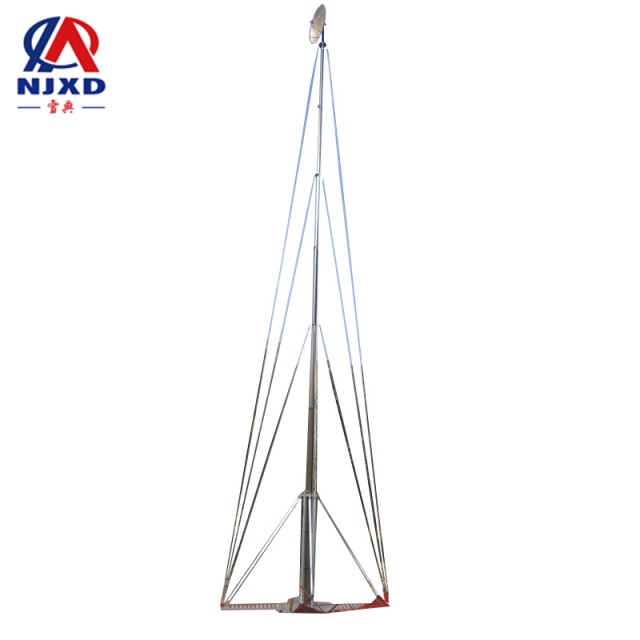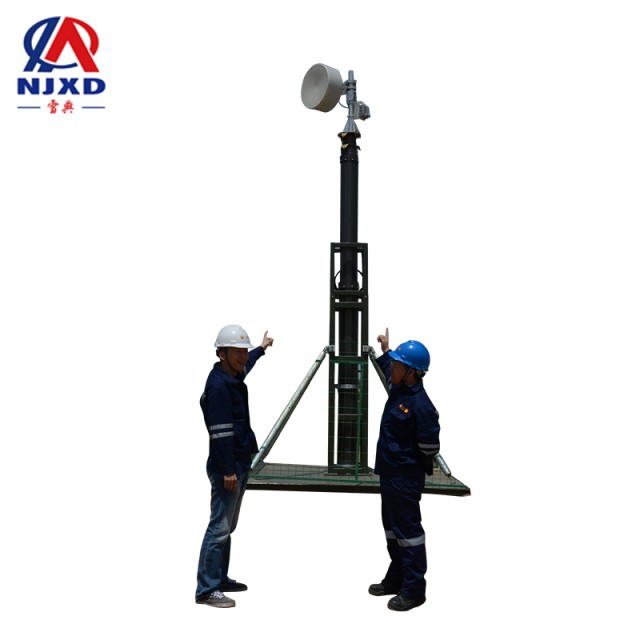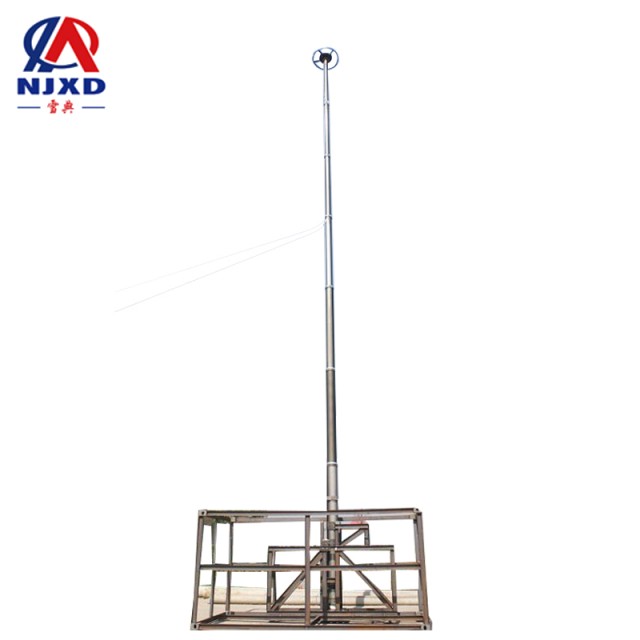NEWS
Classification of radio wave propagation application antenna telescopic mast
Time:2021-07-09 View:

Basic Classification
Radio wave propagation is basically classified according to the research object. Since radio wave propagation is the process of studying the action between radio wave and medium, both radio wave and medium are the research objects. In this way, two types are divided by radio frequency (band) and by medium. According to frequency classification, there are extremely long wave propagation, ultra long wave propagation, long wave propagation, medium wave propagation, short wave propagation, ultra short wave propagation, microwave propagation and millimeter wave propagation; According to medium classification, there are underground radio wave propagation, ground wave propagation, Stratosphere radio wave propagation, ionosphere radio wave propagation and magnetosphere electromagnetic wave, etc. These two categories are basically "parallel" and corresponding to each other, but they are intersecting (see figure).
Due to different media structures and wave wavelengths, the physical mechanisms of radio wave propagation vary. Some are mainly scattering propagation, while others are mainly Waveguide propagation. Different physical mechanisms lead to different communication theories and methods. From this perspective, there are random medium propagation theory (scattering theory), layered medium propagation theory, waveguide mode propagation theory, diffraction propagation theory, magnetic ion theory and inversion theory, etc.
Relationship with other disciplines the basic theoretical starting point of radio wave propagation is electromagnetic theory, namely Maxwell equations and electrodynamics derived from physics. The Earth, the Earth's atmosphere and even the outer space are the media of radio wave propagation, and various media produce rich and colorful radio wave propagation content. In order to study different types of radio wave propagation, we must understand the physical structure and motion changes of different media. For example, studying ground waves requires understanding the Earth's crust, especially the geoelectric characteristics. To study the propagation of the tropopause, we need to know the dielectric properties and their changes in the tropopause, so as to understand the structure and changes of temperature, humidity and pressure, stratification and turbulent motion, etc, we also need to know all kinds of air components, especially oxygen and water vapor molecules, their interaction with radio waves, cloud and mist precipitation, etc. However, the study of ionosphere propagation needs to know the ionosphere electron concentration, geomagnetic and its changes, as well as the influence of sunspot, magnetic storm, Aurora and nuclear explosion. In the study of earth-air radio wave propagation, the physical characteristics of magnetosphere and outer space certainly need to be understood. Therefore, radio wave propagation is based on geophysics, meteorology, atmospheric physics and space physics.
Radio wave propagation is a branch of electronics, which is closely related to other branches of electronics. First of all, radio wave propagation detection requires the use of communication, radar, radio navigation, antenna and other technical equipment, while data processing and test control require the use of electronic computers, the research results of radio wave propagation also serve the design, operation and parameter prediction of these systems.
Because radio waves always carry the information of the transmission medium, reflecting the physical state and changes of the Earth, atmosphere and even outer space, radio wave propagation has now become Geophysical, meteorological, atmospheric physics, one of the commonly used and extremely important observation methods in space physics and astronomy. Ground detection and top detection of ionosphere, magnetosphere, etc. almost all use radio waves. Radio waves are used in meteorology and astronomy, forming a new discipline-Radio meteorology and radio astronomy. In addition to providing means, the detection data and analysis results of radio wave propagation in media are also contributions to the corresponding physics disciplines.
Radio wave propagation theory is particularly closely related to mathematics. It not only uses the latest results in field theory, mathematical physics methods and mathematical statistics, but also promotes the development of these aspects.

Basic form
Ground wave diffraction propagation.
The transmitting antenna is located on the ground, and the electromagnetic wave propagates along the ground surface by diffraction, which is called ground wave diffraction propagation. Due to the difference of dielectric characteristics and radio frequency on the ground surface, the ground wave receives different degrees of attenuation in the propagation process. In the case of close distance, the ground wave field strength can be calculated by using the schulekin-Van der Bohr formula, however, when considering the influence of the earth curvature, the diffraction formula should be used for calculation. ITU-R P.526 gives the transmission loss calculation model of smooth spherical surface radio wave diffraction propagation commonly used in engineering, which is also applicable to smooth sea surface with small roughness.
Line-of-sight propagation.
The transmission mode in which the radio wave is transmitted directly from the transmitting antenna to the receiving antenna or reaches acceptance point after being reflected by the ground. That is to say, the transmitting antenna and the receiving antenna are limited to propagation within the line-of-sight distance that is "seen" from each other. Land mobile communication, personal communication and paging communication are all spread in this way. For ground communication, the height of antenna installation is much higher than the wavelength. Due to the influence of the curvature of the Earth, the longest distance of the radio wave propagation between the transmitting and receiving antennas can be determined by the antenna height.
Scattering propagation.
The radio wave is scattered to acceptance point through the uneven distribution medium in the stratosphere or ionosphere, so that the radio wave reaches the place outside the line of sight. The tropopause is about 10~18 kilometers above the Earth's surface, which is a heterogeneous medium. The reflection index decreases with the increase of height. The applicable wave band and sight distance propagation of scattering propagation are basically the same but far away (for example, ionosphere scattering can reach 2,000 kilometers), so it is over-sight distance propagation for ground communication.
Waveguide propagation. In layered media, there may be a propagation mode similar to that in metal waveguide between layers, which is called Waveguide propagation. This kind of waveguide is a waveguide existing under natural conditions, or other waveguide that is not specially used to propagate radio waves (such as underground tunnels). The propagation of radio waves in the offshore evaporation waveguide belongs to this kind of propagation form. Evaporation waveguide is an abnormal atmospheric structure formed by the rapid decline of water vapor along the offshore surface with the increase of height. It has a high probability of occurrence and a long existence time in a certain sea area. Evaporation waveguide can trap electromagnetic waves of a certain frequency in the waveguide structure to form over-the-horizon propagation of radio waves.

Basic applications
Radio wave propagation is widely used in radio systems. Almost all radio systems involve the problem of radio wave propagation, and the laws of radio wave propagation and relevant formulas, charts, data and materials should be used. Early research on radio wave propagation was carried out to establish and improve radio communication. With the development of electronic technology, electronic system engineering is changing with each passing day, and various radio wave propagation problems are put forward. It is these problems in practical application that have become the starting point and motivation of radio wave propagation research, promoting the development of radio wave propagation research. In turn, every new discovery and progress of radio wave propagation also opens up new technical approaches for electronic system engineering. Radio wave propagation plays a technical Foundation role in electronic system engineering.
The electronic system work frequency band needs to be selected according to the system technical index and radio wave propagation characteristics. Taking underwater submarine communication as an example, in order to make the radio signal pass through the sea without suffering too much loss, only ultra long wave or longer band with small absorption loss in the sea water can be selected. The ultra-long distance precision navigation system uses long wave and ultra long wave, because the propagation attenuation of such radio waves along the ground is very small, and the phase and amplitude are quite stable. Short wave can effectively reflect thousands or tens of thousands of kilometers through the ionosphere. Compared with long wave and ultra long wave, the transmission capacity is larger and the antenna directivity is stronger. Therefore, long-distance communication, broadcast, Marine mobile communication, and over-the-horizon radar are all commonly used in this band. However, large capacity, high quality and high reliability radio communication and high resolution radar must use ultra short wave, microwave, millimeter wave and even shorter wavelength waves.
Another problem of wave propagation that electronic systems must consider is propagation attenuation prediction. Communication, broadcasting and navigation systems must have sufficient radiation power so that the transmitted wave can ensure sufficient signal-to-noise ratio at the receiving end. Therefore, one-way propagation attenuation needs to be predicted. Radar system must predict bidirectional propagation attenuation and target scattering cross section. In order to enable all electronic systems to work without interference, each radio transmission system should also ensure that it does not interfere with other systems, which requires predicting the interference field strength.
The circuit design of electronic system is to a large extent the design of radio wave propagation conditions. For example, the choice of communication station address, the determination of antenna erection height and elevation angle, and how to take effective diversity receiving measures to reduce fading, etc. should be carried out according to the law of radio wave propagation. In addition, the design of system equipment should also adapt to the characteristics of the propagation channel. For example, neither the transmission capacity nor the transmission rate can exceed the allowable limit of the propagation channel.
In terms of radar system, besides propagation attenuation or action distance, stray echo, ground reflection and atmospheric refraction effect should also be considered. Stray echoes, such as terrain echo, HAILANG echo, cloud, rain echo, bird and insect Echo, will affect target detection; Virtual targets caused by ground reflection may cause wrong tracking; atmospheric refraction causes errors between the apparent position and the real position of the target, such as elevation error, distance error, height error and azimuth error. In order to achieve accurate positioning, these factors must be suppressed, eliminated or corrected according to the propagation characteristics. This is especially true for low elevation tracking. In terms of remote sensing technology, the scattering characteristics of radio waves on various rough surfaces and their covering layers are essential knowledge for correctly processing and interpreting data, including various crops, forests, backscattering cross section and spectral characteristics of water surface and water surface pollution, etc.
There are two main ways to apply radio wave propagation in atmospheric physics and other aspects:
① directly use the research results of propagation media detection, such as geoelectric characteristics, precipitation characteristics, tropopause structure and ionosphere structure;
(2) using the propagation law of radio waves, the propagation effects of atmospheric physical processes and so on are given, so as to seek the radio detection and analysis methods of atmospheric physical processes and so on. For example, ionosphere incoherent scattering radar detection is based on the interaction between powerful electromagnetic waves and electrons and ions in the ionosphere in thermal motion, as well as the concentration of electrons and ions contained in scattering signals, information such as temperature and composition.

Development Trend
① with the development of science and technology, radio wave propagation is further expanding the research and application fields. For example, the biological effects of electromagnetic waves and the study of electromagnetic phenomena during earthquakes are likely to make progress.
(2) establish a more perfect and accurate radio wave monitoring system to obtain more complete media and propagation characteristic data. Summarize the mathematical model which is closer to the reality, and quickly provide environmental data and radio wave prediction data by using electronic computers.
③ combine more closely with the research of geophysics, space physics, astrophysics, atmospheric physics and so on to play the role of radio wave propagation in these physical research.
